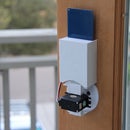Introduction: Color Visualizer
Ever wanted an interactive and simple soldering kit for beginners? The Color Visualizer has three potentiometers, resistors, a battery pack, and an RGB LED to make a simple soldering kit, and an interactive project all in one!!! I originally came up with the design, and prototyped it on a breadboard as a proof of concept. Then, using rapid prototyping software, I developed a PCB, or printed circuit board, within minutes.
When you twist the corresponding potentiometer, the corresponding color receives more voltage. You can constantly change the RGB LED's color with the potentiometers, as long as the battery is connected.
People seem to like it because you can have literally millions of combinations with the RGB LED, with no programming, only soldering. It is a great gift for young learners, and newbies to electronics. When you solder the kit, not only do you learn how voltage works, but you also learn about great concepts such as Ohm's law, current, and how to use the latest lighting technology, LEDs.
The Color Visualizer kit will soon be available as a soldering kit on my website, Qtechknow.com, but you can make your own on a breadboard today! Check out the schematic above to make your own.
What did you make?
I made the Color Visualizer, a beginner's soldering kit that is interactive. It uses three potentiometers to change the color of the RGB LED onboard. There is no microcontroller or programming skills needed, for you only need to know how to turn a dial/potentiometer. I believe that this project is special because it is one of the first interactive simple soldering kits that I have ever seen. You determine what color the RGB LED is, not a microprocessor.
How did you make it?
First, as all makers do, I prototyped it on a breadboard for a proof of concept. It surprisingly worked the first time, so I went to Eagle CAD to design a PCB for the project. When the PCB arrived 2-3 weeks later, I then realized that the prototype boards had copper traces that were in the wrong spot. Soon, however, I'm going to release these on my website once I've made my revisions.
Where did you make it?
I made it at my projects desk, and in my hackerspace (Qtechknow Labs). I used a breadboard at my desk to make the proof of concept, my laptop to make the PCB in Eagle CAD, and my hackerspace to solder some prototypes.
What did you learn?
I learned that nothing works the first time, and that you can fix your mistakes. As I mentioned before, I accidentally messed up on the copper traces on the PCB, but I still have prototypes that work, because I improvised. I noticed that the footprint for the Piranha LED from SparkFun was different, so instead of cutting the traces on every board, I just took a standard RGB LED and bent the wires in a different way so that it would work correctly.

Participated in the
Lamps & Lighting Contest

Participated in the
Epilog Challenge V

Participated in the
Make-to-Learn Youth Contest













